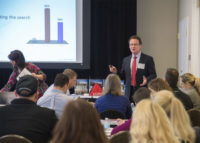Blogger and futurist Seth Godin had a great post the other day about the importance of listening. And maybe that’s what associations should be doing more of when they talk about the next generation of their annual meetings, conferences and conventions—listening.
As association professionals, we have lots of clever ways to talk to members through our communications and live events, but are we really listening to what they have to say? What do sponsors and exhibitors really want from us? What are members saying to each other? “Listening is not a passive act if you want to do it right,” wrote Godin. “If listening better leads to better speaking, then [listening] becomes a competitive advantage.”
|
As conferences and conventions evolve, organizations that perfect their listening skills will have the best chance of staying relevant. Post-show surveys can be very valuable, but only if you ask the right questions. Mobile conference apps add convenience and can help build communities around the show. Appointment-based events bring pre-qualified buyers and sellers together for carefully targeted one-on-one discussions. |
So why don’t we simply ask our constituents what they want from us in our member surveys? Why do more and more registrants wait until very the last minute before committing to attend?
“Member surveys can tell you a lot, but associations are often afraid to ask the right questions,” said Camille Stern, vice president and group show director at NaylorCMG. The other challenge with surveys, observed Stern, is that associations often don’t do anything with the results they’ve worked so hard to gather. They may put the results in a report, but they don’t really change anything until it’s time to do the next annual survey.
Only a small number of associations “make the effort to follow up with people who give negative feedback,” said Stern. Instead of saying X percent of members were satisfied with the annual conference, “you’ve got to ask the ones who weren’t satisfied why they weren’t satisfied,” she said.
“Associations don’t always listen (or want to listen) to what members tell them.”
Associations put a great deal of time and effort into their annual conferences, even though only a small portion of their membership actually attends, noted to Jeff DeCagna, founder of Principled Innovation. The rest have lots of other ways to get the learning, networking and connections they need. And associations aren’t taking advantage of that, he added.
Why don’t they?
For one, there’s a lot of money on the line, as the annual conference or convention is often an association’s biggest non-dues revenue generator. It’s also a great source of visibility and prestige. As our annual communication benchmarking studies have revealed, industry event coverage is considered highly important to nearly 40 percent of association leaders, up substantially from 22 percent in 2011.
Getting more out of the experience
Even a bleeding edge technologist like Godin argues that “live interaction still matters. Teachers, meetings, presentations, one-on-one brainstorms—they can lead to real change.”
“You just can’t substitute the impact of meeting face to face,” agreed Jim Anderson, president of the California Society of Association Executives. Attendees and exhibitors are very ROI focused today and they’re expecting an “experience” that they can’t find anywhere else.
Giovanni Livera, a popular motivational speaker and performer for corporate and association gatherings said the greatest benefit you can offer members is the hope that they will be “transformed by joining your organization.” Your annual meeting has to play a big role in that experience, he added.
Livera, a self-described “possibilitarian,” said associations do a great deal of work to prepare for their conferences, but they often forget a key ingredient to success: getting attendees in the right frame of mind to be inspired. “You’ve got to lose the pre-conference baggage and suck all the negative energy out of the room.” Most people got into the association realm because they love the work and they love the people, observed Livera.
But, over the course of their jobs, “the fun meter starts to go down.” You have to get attendees reinvigorated and re-inspired about their work. It’s just hard to duplicate that energy without being there in person, he said.
Mobile conference apps
Mobile conference apps are another fast-growing way to help attendees and exhibitors get more out of their show experience. “Mobile is the new paradigm for connecting, participating and collaborating,” observed DeCagna. Beth Brooks, president of the Texas Society of Association Executives, said the mobile conference app developed by Naylor has been very popular with members. “I especially love the ‘customize my schedule feature.’”
But, there’s more to conference apps then scheduling, noted Marcus Underwood, vice president and general manager of NaylorNet. Today, the new generation of apps is not just helping attendees navigate a massive show floor or busy program agenda, they’re helping users build true online communities centered on the show.
Appointment-based events
Another fast-growing event trend is orchestrating pre-set appointments between your industry buyers and sellers. Sometimes known as exchange events or “B2B speed dating,” appointment-based events bring pre-qualified purchasers and vendors together at a pre-set time and location.
At most organizations, appointment events are held months apart from the annual trade show or conference. They’re designed to supplement the conference show floor or exhibit hall, not replace it.
CalSAE’s Jim Anderson said his annual appointment-based Exchange event is getting very positive response and sells out quickly. With nearly two-dozen appointment desks set up in the same room, each vendor can have eight to 10 meaningful dialogues with highly qualified buyers in the space of two hours. Due to strong demand, appointment desks are reserved only for those who exhibit regularly at CalSAE’s annual conference in the spring.
Rob Ingraham, executive vice president of Naylor’s Global Exchange Events,said appointment-based events are “all about discussions.” Typically 60 to 75 top buyers from a single industry are paired with an equal number of key suppliers for pre-qualified 20-minute appointments. On top of the appointments, Ingraham’s events feature keynote speakers, social events and planned networking sessions at a resort location. As with other types of association interaction, Ingraham said the most successful sellers at his events are the ones who really know how to listen.
Conclusion
“The best way to honor someone who has said something smart and useful is to say something back that is smart and useful,” Godin posted recently. “Good listeners will get what they deserve.”
Is your organization taking time to listen to what members and suppliers are dying to tell you?
By Hank Berkowitz,moderator-in-chief of Association Adviser enews.
Source: www.associationadvisor.com



